I drove down to the University of Texas campus in Austin to attend a screening of Revenge of the Electric Car and a panel discussion regarding electric vehicles, battery technology and the grid’s preparedness for the coming revolution.
From The Statesman: “The future of the electric vehicle market is the subject of a panel and film screening on University of Texas campus on Tuesday.
The event, free and open to the public, includes a discussion by panelists from General Motors, Nissan, Toyota, UT and Frontier Associates and a screening of the documentary Revenge of the Electric Car.
Among the questions the panelists will take up is whether battery prices will ever go low enough to make electric cars vehicles more competitive with gasoline-powered.
The event, organized by the Electric Vehicle Transportation and Electricity Convergence Center, a joint effort of Texas A&M University, UT and the National Science Foundation, will be held 4 to 8 p.m. on Tuesday at the Blanton Museum at 200 E. Martin Luther King, Jr. Blvd.”
(Video shot with my iPhone 5 and reduced to 720P. The event people had a professional camera there making a video of the the discussion. If I see them post it, I’ll add a link to it)
If you haven’t seen Revenge of the Electric Car, I highly recommend it. It is available on Netflix.
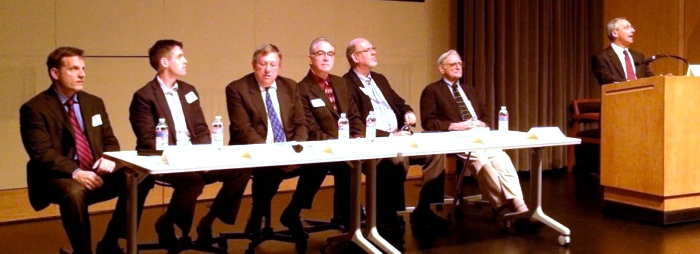
Panel members, left to right were:
- Joseph R. Thompson, representing Nissan North America
- Michael Lewis, Senior Engineering Scientist at UT’s Center for Electromechanics
- Michael Love, representing Toyota Motor Sales, Inc.
- Craig Eppling, Regional Communications Manager of General Motors
- Mark Kapner, Director of Engineering, Frontier Associates
- Professor John B. Goodenough, Ph.D, the Virginia H. Cockrell Centennial Chair in Engineering – Mechanical Engineering at UT, “Father of the Lithium Battery”
- Dr. Ross Baldick, Ph.D, Leland Barclay Fellow in the Department of Electrical and Computer Engineering at UT (standing at podium)
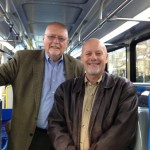
One pleasant surprise: The presence of an extended range electric bus, made by Proterra, out of South Carolina. You’ve got to love the name of the company. If you’re visiting my blog, you are definitely pro-Terra…
 I was fortunate in arriving early for the event. Doing so gave me the opportunity of meeting Dale Hill, the founder of Proterra and getting to speak with him alone for an extended period. The bus, shown below uses hydrogen fuel cells instead of a diesel engine to extend the range of the bus.
I was fortunate in arriving early for the event. Doing so gave me the opportunity of meeting Dale Hill, the founder of Proterra and getting to speak with him alone for an extended period. The bus, shown below uses hydrogen fuel cells instead of a diesel engine to extend the range of the bus. 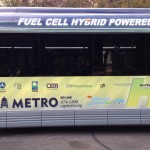 It’s sort of like a Volt that can carry 64 people. This particular bus actually has a route it runs in Austin every day. Most buses made by Proterra (like the ones they’ve deployed in San Antonio) don’t use fuel cells but instead, have a five minute stop every hourly cycle through their route. This stop is at the charging station and, in five minutes, it replaces the energy expended in the previous hour of driving and continues on, to the next loop around town. This bus however, uses the hydrogen fuel cells to recharge the battery pack while the bus is driving its route!
It’s sort of like a Volt that can carry 64 people. This particular bus actually has a route it runs in Austin every day. Most buses made by Proterra (like the ones they’ve deployed in San Antonio) don’t use fuel cells but instead, have a five minute stop every hourly cycle through their route. This stop is at the charging station and, in five minutes, it replaces the energy expended in the previous hour of driving and continues on, to the next loop around town. This bus however, uses the hydrogen fuel cells to recharge the battery pack while the bus is driving its route!
According to their brochure, bus mileage works out like this:
- Compressed Natural Gas – 3.27 MPG / $0.70 per mile
- Hybrid – 4.5 MPG / $0.90 per mile
- Diesel – 3.86 MPG / $1.05 per mile
- Proterra – 24 MPG (wow) / $0.18 per mile
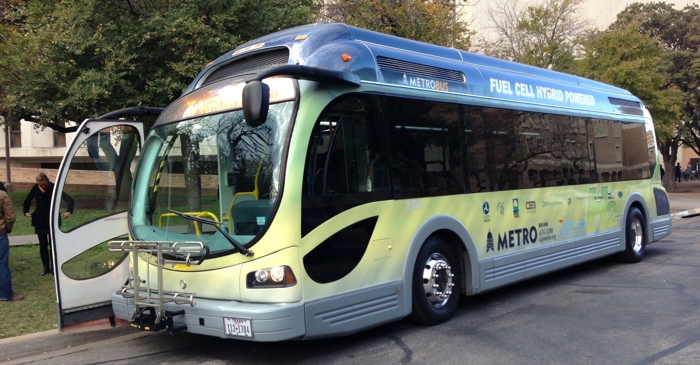
 Dale played a video on his iPad, showing the charging procedure for their buses. It is amazing. The charger connection is on the roof of the bus, so the charger is on what appears to be a lamppost. When the bus approaches, a bluetooth connection is made and the charger takes over control of the bus, guiding it to the location needed for the charger to engage with the bus. A video of this procedure is available in the media section of the Proterra website.
Dale played a video on his iPad, showing the charging procedure for their buses. It is amazing. The charger connection is on the roof of the bus, so the charger is on what appears to be a lamppost. When the bus approaches, a bluetooth connection is made and the charger takes over control of the bus, guiding it to the location needed for the charger to engage with the bus. A video of this procedure is available in the media section of the Proterra website.
He mentioned that buses typically are cost justified on a 12  year service life. Although this bus is considerably more expensive than a diesel bus, the savings in fuel and maintenance make up that difference within 10 years. Financing can be set up such that the monthly budget impact is similar to a traditional, diesel bus with a portion of the financed payment being made through the fuel savings.
year service life. Although this bus is considerably more expensive than a diesel bus, the savings in fuel and maintenance make up that difference within 10 years. Financing can be set up such that the monthly budget impact is similar to a traditional, diesel bus with a portion of the financed payment being made through the fuel savings.
One unpleasant surprise: The Volt can cruise fast enough and long enough that, even in a 75 mile per hour speed zone, one can get a speeding ticket. Bummer.

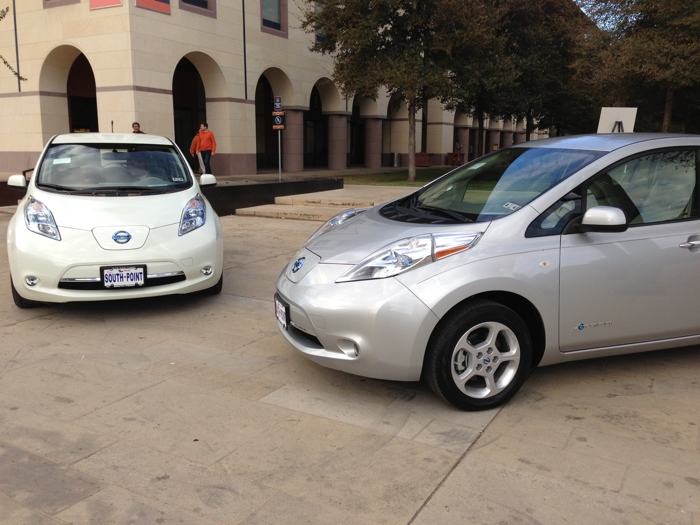 South Point Nissan of Austin had a couple Leafs on display in front of the meeting venue.
South Point Nissan of Austin had a couple Leafs on display in front of the meeting venue.

Oh no! Hillsboro is a known speed-trap on I-35. But, at 75mph, most traffic would be passing you by…!
THAT’S why I need to move to Austin! (among other reasons…)